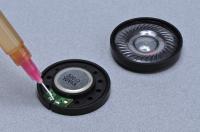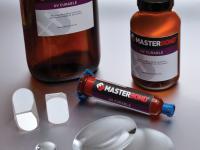
Join Venkat Nandivada, Manager Technical Support, for a Q&A about the role glass transition temperature plays in selecting an adhesive for a high temperature application.
Q: What are some of the factors an engineer should consider when selecting an adhesive for high temperature applications?
A: The operating temperature range in an application is one of the key factors in determining the type of adhesive to be used. For higher temperature applications, it is important to take into account the maximum operating temperature that the cured adhesive will be exposed to, as well as the duration and frequency of this exposure. Other factors which influence the choice of an adhesive in a high temperature application are: types of substrates, thermal cycling profile, chemical resistance requirements, mechanical forces involved, as well as handling and processing constraints such as viscosity, cure time, and cure temperature.
The glass transition temperature (Tg) is also an important consideration in such applications. For example, in an application with long term operating temperature of around 200 °C, an adhesive with a Tg 200 °C could be a good option to evaluate. On the other hand, if an application involves a short term, one time exposure (such as a few seconds or minutes), to temperatures such as 200 to 300 °C, a high Tg adhesive is not required.
Q: Can you provide an explanation of glass transition temperature / Tg?
A: The temperature at which the epoxy adhesive changes from a rigid glassy state to a more pliable form is known as Tg. This thermal property acts as a good guideline of the ability of an adhesive product to stand up to sustained exposure to high temperatures.
As the temperature increases, thermosetting polymers exhibit changes in their physical properties, including tensile strength, thermal expansion, heat capacity, modulus, electrical properties, and others. One significant change is that of the linear coefficient of thermal expansion (CTE). As a material moves through the glass transition temperature range, its CTE increases dramatically — ultimately becoming three to five times higher than its value below the Tg range. After the epoxy passes through the glass transition temperature range, its material properties are significantly different from those below the Tg range. These changes are not necessarily permanent, however; they depend upon the duration and extent to which the Tg range is exceeded. Brief excursions above the Tg will not irrevocably “damage” the material. As an epoxy returns to ambient temperatures, its strength profile is typically restored. It is important that design engineers understand the nature of this transition so that they can choose the best system for a specific application.
Q: What are the exceptions to the relationship between heat resistance and a high Tg?
A: Certain silicones and B-staged flexible epoxies do not necessarily follow these rules. Due to the unique nature of the molecular backbone of silicones and the flexible cure state of some B-stage epoxies, these have both considerably low Tg and good heat resistance, whilst still maintaining their flexibility in extremely high temperatures.
For example, a few B-staged epoxies offered by Master Bond have a Tg of around 35°C, but they are serviceable up to 260°C.
Q: What products does Master Bond formulate to match the extremities from a thermal standpoint?
A: Master Bond has a line of several high and low temperature resistant epoxies, silicones, and many UV curing compounds, many of which can be custom blended to meet specific requirements. A few examples are noted below.
Q: What should one be mindful of regarding the curing process for temperature resistant adhesives?
A: The grades with the very best resistance to high temperatures tend to be products which need an oven cure. With many epoxies, curing at higher temperatures for an extended time period helps to increase the Tg, and optimize temperature resistance as well as other cured properties. Basically, the Tg is extremely dependent on the cure schedule used for the epoxy.
Many one component silicones require moisture or humidity for curing. Some of these systems can resist temperatures as high as 200 to 300 °C, but will not cure properly if there is limited or no access to moisture.
It is of course important to be aware of the manufacturer’s handling, processing, and curing recommendations.
High Tg Adhesives
 |
EP17HT-LO One part, no mix epoxy meets NASA low outgassing specifications. Serviceable up to 600°F. Tg is 225°C. High shear, tensile and compressive strength properties. Cures in 90-120 minutes at 300F. Withstands 1000 hours 85°C/85% RH. |
 |
Supreme 121AO Thermally conductive, electrically insulative. Outstanding dimensional stability. Passes NASA low outgassing tests. Very long open time. Ideally suited for potting applications. Serviceable from -80°F to +550°F. Black in color. Requires oven curing. |
 |
EP21TCHT-1 Two part, room temperature curable epoxy system with high thermal conductivity. Serviceable from cryogenic temperatures up to +400°F. Electrically isolating. Meets NASA low outgassing specifications. Halogen free. Paste consistency. Formulated to cure at ambient temperatures. Withstands 1,000 hours 85°C/85% RH. |
 |
UV25 Multi-purpose, one part UV curing system for bonding, sealing, coating and encapsulation. Excellent optical clarity, superb physical properties, moderate viscosity. Ultra high glass transition temperature (Tg) over 180°C. Fast fixture times. Rapid curing. Serviceable from -60°F to +500°F. |
 |
EP114 Two component nanosilica filled epoxy for potting, coating and sealing. Optically clear. Low shrinkage. Superior electrical insulation properties. Toughened system. Successfully tested for 1,000 hours 85°C/85% RH. Serviceable from -100°F to +450°F. |
 |
EP17HTS-DA Silver filled, one part, no mix, die attach epoxy with electrical conductivity and high temperature resistance. It is a silver filled system. This specialty formulation maintains a high Tg of 140-150°C and passes MIL-STD-883J thermal stability requirements at 200°C. |
